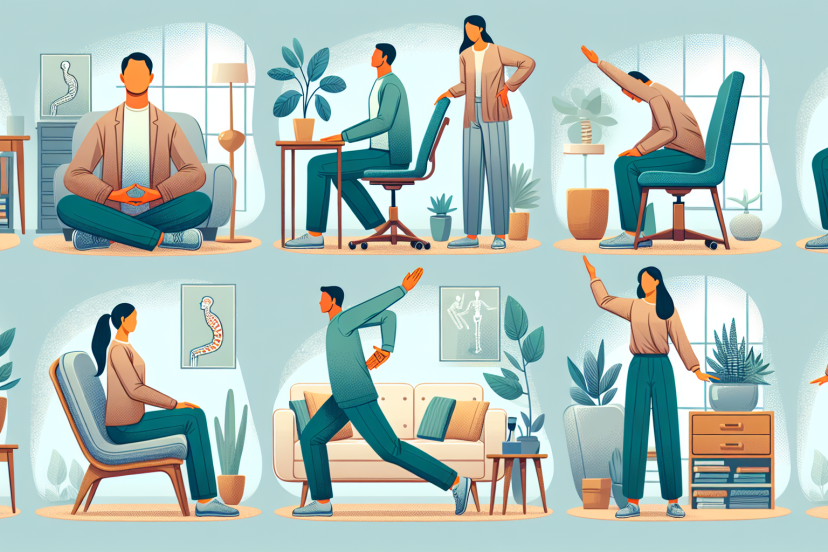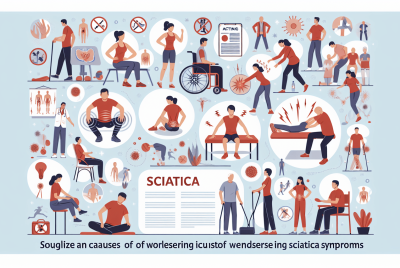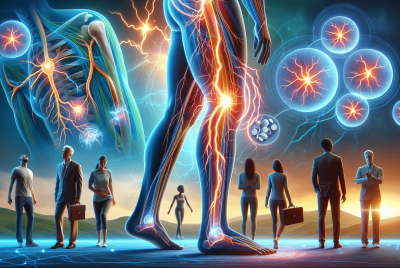Top Tips for Relieving Back Pain at Home
Are you tired of dealing with persistent back pain? Look no further! In this article, we will provide you with the top tips for relieving back pain in the comfort of your own home. Say goodbye to constant discomfort and hello to a pain-free life. From simple stretches to easy exercises, we have got you covered. So, grab a cup of tea, sit back, and get ready to discover the best ways to alleviate back pain and restore your overall well-being.
Exercise and Stretching
When it comes to relieving back pain at home, incorporating exercise and stretching into your routine can be incredibly beneficial. Low impact aerobic exercises, such as walking, swimming, or cycling, can help improve blood flow, strengthen muscles, and reduce back pain. These exercises are gentle on your joints and provide a great cardiovascular workout without putting too much strain on your back.
Stretching is also essential for improving flexibility and relieving tension in your muscles. Simple stretches like hamstring stretches, cat-camel stretches, and trunk rotations can help alleviate back pain and improve your overall range of motion. Regular stretching can also prevent muscle imbalances and promote proper alignment, which are crucial for maintaining a healthy back.
Yoga and Pilates are two fantastic options for back pain relief. These practices focus on increasing core strength, improving posture, and enhancing flexibility. Yoga incorporates movements that stretch and strengthen different muscle groups, while Pilates focuses on building a strong core through controlled movements. Both disciplines can help alleviate back pain and promote a healthier spine.
Improving Posture
Maintaining a neutral spine is vital for preventing and relieving back pain. When standing or sitting, it’s crucial to avoid slouching and maintain proper posture. Keep your shoulders relaxed, your head aligned with your spine, and your chin parallel to the ground. Engaging your core muscles can also help support your back and improve your posture.
Sitting and standing ergonomics play a significant role in maintaining good posture. When sitting, make sure your feet are flat on the floor, your knees are bent at a 90-degree angle, and your lower back is supported by a chair with proper lumbar support. Adjusting the height of your chair and using a footrest if needed can also help maintain a neutral spine. Similarly, when standing, distribute your weight evenly on both feet, avoid locking your knees, and stand tall with your shoulders back.
Using supportive furniture, such as ergonomic chairs and desks that promote good posture, can make a world of difference in your back pain relief efforts. Look for chairs with adjustable features and lumbar support, and desks that allow you to maintain a comfortable seated or standing position.
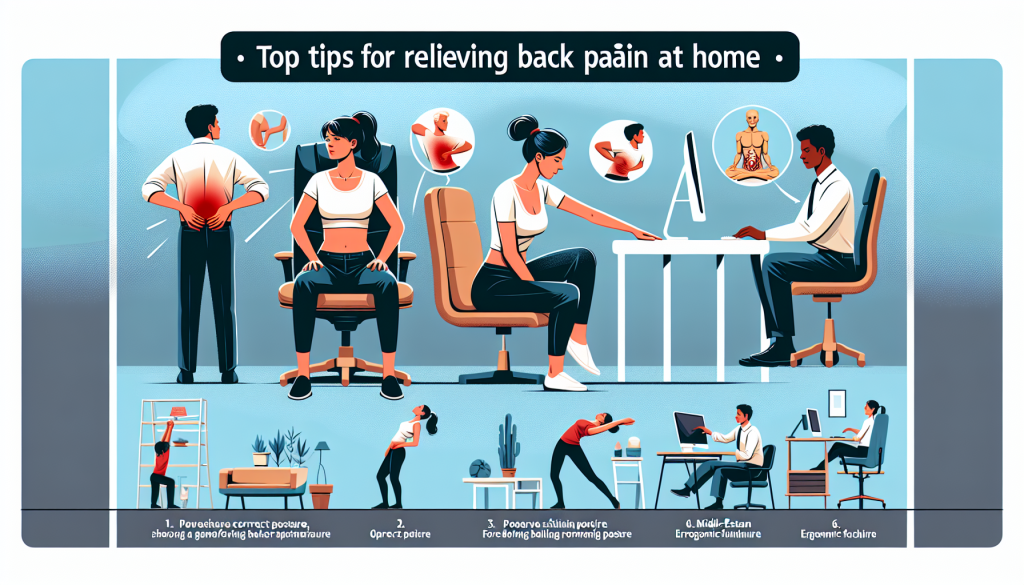
Applying Heat and Cold
Heat and cold therapy are simple yet effective ways to alleviate back pain at home. Applying a hot compress or heating pad to the affected area can help relax tight muscles, increase blood flow, and reduce inflammation. Heat therapy is particularly beneficial for muscle spasms and chronic back pain. Make sure to use a towel or cloth to protect your skin and limit the application to 15-20 minutes at a time.
On the other hand, cold therapy can help numb the area, reduce swelling, and alleviate acute pain. Using a cold compress or ice pack on your back for about 15-20 minutes can provide relief. Remember to wrap the ice pack in a towel or cloth before applying it to your skin to protect yourself from frostbite.
Contrast therapy, which involves alternating between hot and cold treatments, can also be effective for back pain relief. Start with a hot compress or heating pad for around 5 minutes, followed by a cold compress or ice pack for 1-2 minutes. Repeat this cycle several times, ending with a cold treatment. The combination of heat and cold can help promote circulation and reduce pain and inflammation.
Sleeping Position and Mattress
Your sleeping position and mattress play a crucial role in managing and preventing back pain. Choosing the right mattress can provide adequate support and alignment for your spine. Look for a medium-firm mattress that contours to your body shape without sinking too much. This balance of support and cushioning can help relieve pressure points and maintain a neutral spine while you sleep.
When it comes to sleeping positions, some are better for your back than others. Sleeping on your side with a pillow between your knees can help align your spine and reduce strain on your lower back. If you prefer sleeping on your back, place a pillow under your knees to maintain the natural curve of your spine. Avoid sleeping on your stomach as it can strain your neck and put pressure on your spine.
Using pillows strategically can also provide additional support for your back. Placing a pillow under your lower back or using a full-body pillow for added support can help promote proper spinal alignment and reduce back pain during sleep.
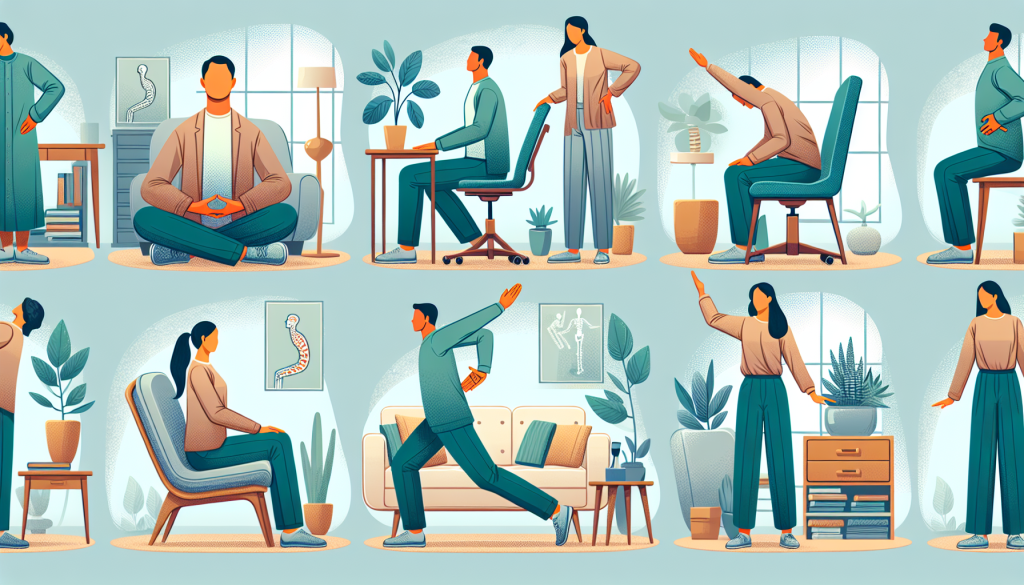
Ergonomic Workstation Setup
If you spend a significant amount of time sitting at a desk, setting up an ergonomic workstation is crucial for preventing back pain. Start by adjusting your desk and chair to the proper height to ensure that your elbows are at a 90-degree angle when typing, and your monitor is at eye level. This positioning helps maintain good posture and reduces strain on your neck and back.
Taking regular breaks throughout the day is also essential. Sitting for long periods can worsen back pain and lead to muscle stiffness. Stand up, stretch, and walk around for a few minutes every hour to give your back a break. Incorporating small exercises, such as shoulder rolls or neck stretches, can also help relieve tension and promote blood flow.
Pain-Relieving Products
There are various pain-relieving products available that can provide additional support and alleviate back pain. Back support belts can help stabilize your spine and provide extra support when engaging in physically demanding activities. These belts are particularly useful if you have a history of back problems or need additional support during exercises or heavy lifting.
Orthopedic cushions are designed to provide comfort and support to your back while sitting for extended periods. They often have contouring or memory foam that helps distribute your weight evenly and reduce pressure on your lower back. These cushions can be a great addition to your ergonomic workstation or used in your car or when sitting for extended periods.
For individuals with chronic back pain, inversion tables can offer relief by decompressing the spine. These tables allow you to hang upside down or at an inverted angle, reducing the pressure on your spine and relieving pain. However, it’s essential to consult with a healthcare professional before using an inversion table, especially if you have any underlying health conditions.
Maintaining a Healthy Weight
Maintaining a healthy weight is crucial for overall well-being, and it can significantly impact back pain. Excess weight puts additional stress on your spine and can contribute to the development or worsening of back pain. Incorporating regular exercise and following a balanced diet can help you maintain a healthy weight and reduce the strain on your back.
Regular exercise, such as aerobic activities, strength training, and stretching, can help you shed excess pounds while strengthening your muscles to support your spine. Focus on exercises that are low impact and gentle on your joints. Additionally, adopting a balanced diet rich in fruits, vegetables, lean proteins, and whole grains can provide the necessary nutrients for a healthy back.
Stress Management
Stress can manifest physically, and chronic stress can contribute to back pain. Managing stress is essential for overall well-being and can also alleviate tension in your back muscles. Incorporating relaxation techniques into your daily routine can be incredibly beneficial.
Practicing deep breathing exercises, progressive muscle relaxation, and guided imagery can help reduce stress and tension in your body. These techniques can calm your mind, relax your muscles, and promote a sense of overall well-being. Meditation and mindfulness practices can also be helpful for managing stress and reducing back pain. Taking time to focus on the present moment and engage in self-care can do wonders for your physical and mental health.
Engaging in stress-reducing activities is another effective way to manage stress and promote back pain relief. Activities such as walking in nature, listening to calming music, practicing yoga or tai chi, or engaging in hobbies that you enjoy can all help reduce stress levels. Find what works best for you and make it a priority to incorporate stress-reducing activities into your daily routine.
Over-the-Counter Medications
Over-the-counter medications can provide temporary relief from back pain, especially when used as directed. Nonsteroidal Anti-Inflammatory Drugs (NSAIDs) such as ibuprofen or naproxen sodium can help reduce inflammation and relieve pain. These medications can be effective for mild to moderate back pain and are widely available.
Another option is topical pain relievers, such as creams, gels, or patches, which can be applied directly to the affected area. These products often contain ingredients like menthol or capsaicin, which create a cooling or warming sensation that helps alleviate pain.
Muscle relaxants can also be used for short-term relief from severe muscle spasms. These medications work by relaxing the muscles and reducing pain. However, muscle relaxants should be used under the guidance of a healthcare professional, as they can have side effects and interactions with other medications.
When to Seek Medical Attention
While many back pain issues can be effectively managed at home, there are instances where medical attention is necessary. If you experience persistent or severe back pain that is not alleviated by home remedies, it may be time to consult a healthcare professional.
Back pain accompanied by other symptoms, such as numbness or tingling in the legs, difficulty urinating or having a bowel movement, or unexplained weight loss, should also be evaluated by a medical professional. These symptoms can indicate underlying conditions that require prompt medical attention.
If you have a history of back problems or previous injuries and experience a recurrence of pain, it’s important to seek medical advice. Healthcare professionals can diagnose the root cause of your pain and provide appropriate treatment options.
In conclusion, alleviating back pain at home requires a comprehensive approach that incorporates exercise, stretching, maintaining proper posture, applying heat and cold, optimizing your sleeping position and mattress, setting up an ergonomic workstation, using pain-relieving products, maintaining a healthy weight, managing stress, using over-the-counter medications when necessary, and knowing when it’s time to seek medical attention. By implementing these strategies and making them a part of your daily routine, you can effectively relieve and prevent back pain, promoting a healthier and more comfortable life.

